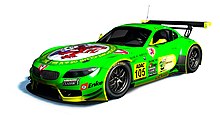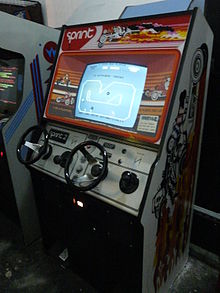Racing simulation

A racing simulation is a computer game of the racing game type in which the player in the role of one of the competing drivers has to control a vehicle that is simulated as realistically as possible to win. In addition to driving, sim racing is also increasingly focusing on live broadcasts , which can be found on YouTube and Twitch . Here, a mix of e-sports transmission and motorsport transmission is increasingly oriented.
history
As with all simulation games , technical advances have made it possible to simulate racing events more and more closely. Games, which at the time of their publication represented the best approximation of reality and can therefore be counted in the simulations, were later far exceeded by the state of the art.
Especially the arcade machines , which appeared from 1976 and were the predominant platforms until the appearance of home computers in the early 1980s, do not appear as simulations compared to the state of the 2000s.
The era of arcade simulations
The first racing game was Gran Trak 10 by Atari (1974). This arcade game was the first to have a steering wheel as well as a 4-speed gearshift, brake and accelerator pedals. The game was black and white and you saw the action from a bird's eye view.
The F-1 electromechanical projection system sold by Atari / Namco from 1976 onwards can be regarded as the first 3-D racing simulation , which already used the first-person perspective typical for most games of this genre. However, this is not a video game since no monitor is used.
The arcade machine Indy 4, also released by Atari in 1976 , showed the racetrack from a bird's eye view, but already took into account the condition of the ground and was at the same time the first multiplayer racing simulation.
Also in 1976, the arcade game Night Driver was made by Atari. It was a black and white game. You could see white bars on the left and right. The car was glued to the monitor as a plastic sheet. Night Driver is considered to be the first video game racing simulation. In the same year Fonz from Sega / Gremlin appeared, a motorcycle simulation that was controlled via a motorcycle handlebar. This was the first attempt to make the racing simulation even more realistic by designing the input devices realistically.
Further milestones:
- Sprint 2 (Atari, 1976) 1. Microprocessor-based racing game
- Monaco GP (Sega, 1980) 1st racing game in a sit-in case, color graphics and stereo sound
- Out Run (Sega, 1986) 1st racing game with force feedback
- Cruis'n USA (Midway, 1994) 1st racing game with reality mapping
Pole Position , published by Atari in 1982, was the first racing simulation to reproduce the processes of a real race: qualifying and racing were separate parts of the game. As is customary in modern racing simulations, the presentation took place in the first-person perspective, and a variant of the arcade machine had three screens in order to offer the driver sitting in a simulated cockpit a panoramic perspective of the race and thus a realistic visual impression to convey.
All further racing simulations were based on the technology from pole position .
The successor to Pole Position was the TX-1 (Tatsumi, 1983) with 3 monitors that were slightly angled next to each other. Buggy Boy was available with 1 or 3 monitors.
The game Out Run (Sega, 1986) was very successful . This was also available in a version with a small Ferrari to sit in. For the first time there was force feedback.
Further development on home devices
With the advent of home computers , it was possible to significantly increase the complexity of the simulation. The economic success of a game sold to home users no longer depended, as with arcade machines, on whether the game was easy to learn to use and a single game was completed in a few minutes so that the machine was available to the next paying customer.
The most important milestone of the home computer era was the Revs developed by Geoff Crammond in 1984 for the BBC home computer and the C64 . It offered setup options (angle of attack of the front and rear wings), a realistic physics model and two realistic race tracks ( Silverstone Circuit and Brands Hatch ). While the course of the game provided for qualification and races as in pole position, the computer opponents were no longer slow obstacles that appeared randomly as in the arcade machine. Instead, Revs offered a full array of drivers, each with their own name, a car in their own colors and their own pace.
An unusual simulation was the stunts published by Brøderbund in 1990 . It deviated from the imitation of a real sporting event that is typical for sports games, but had a realistic and flexible physics model that made it a real simulation despite the unrealistic racetracks that offered jumps, loops and other obstacles. Unlike most previous simulations, stunts made it possible (and necessary) to use the third dimension.
- 1983 - Checkered Flag - the first attempt at realistic driving simulation
- 1984 - Revs - relatively realistic, Silverstone as the only track
- 1989 - Indianapolis 500 - allows changes to the setup
- 1992 - Geoff Crammond's Grand Prix - allows to re-enact the 1991 Formula 1 season, at that time impressive graphics
- 1993 - IndyCar Racing - contains real drivers and teams for the first time
- 1994 - NASCAR Racing - contains a realistic damage model and tire wear
- 1996 - Geoff Crammond's Grand Prix 2 - contains the complete 1994 Formula 1 season and for the first time also the real teams and drivers
- 1997 - Gran Turismo - first game with over 100 licensed vehicles
- 1998 - Grand Prix Legends - simulates the 1967 Formula 1 season
- 1999 - Gran Turismo 2 - first game with over 500 vehicles
- 1999 - NASCAR Racing 3 - is still considered one of the best NASCAR simulations today and served as the basis for iRacing
- 2000 - Geoff Crammond's Grand Prix 3 - much improved force feedback and a variety of wet conditions
- 2001 - Gran Turismo 3 - sold 14.8 million times, the first Gran Turismo on the PlayStation 2
- 2003 - Geoff Crammond's Grand Prix 4 - still one of the best computer opponents to this day
- 2003 - Live for Speed - first pure online simulation
- 2004 - Richard Burn's Rally - still one of the best rally simulation today
- 2004 - Gran Turismo 4 - first Gran Turismo game with real tracks (exception: Laguna Seca in the 2 previous parts)
- 2005 - rFactor - technically advanced tire and aerodynamic model
- 2005 - Forza Motorsport - Microsoft's answer to the success of the Gran Turismo series
- 2006 - GTR 2 - simulates the 2003 and 2004 FIA GT championships
- 2008 - iRacing - online simulation, supported by several real racing series etc. a. the IndyCar series
- 2009 - F1 2009 - first game in the F1 series from Codemasters
- 2010 - F1 2010 - first game in the F1 series for the PC
- 2010 - Gran Turismo 5 - over 1000 cars and 70 tracks, first Gran Turismo game with an online mode
- 2013 - RaceRoom Racing Experience - free base game with realistic computer opponents and sounds
- 2013 - rFactor 2 - preferred simulator of real motorsport teams
-
2014 - Assetto Corsa - extensive collection of cars and tracks with many modding options
 Fully configured skin in Assetto Corsa for the ADAC Digital Cup
Fully configured skin in Assetto Corsa for the ADAC Digital Cup - 2015 - Project Cars - first game in the Project Cars series with 65 cars and 36 tracks
- 2017 - F1 2017 - first game of the F1 series which hosted the Formula One Esports Series
Periphery
In order to get a realistic driving experience, most of the racing simulations can be controlled with keyboard , game controller and joystick as well as with special steering wheels , pedals and selector levers . The control through the rotation and force detection is also much more precise and the haptic perception and the force feedback ensure a more realistic experience. Some manufacturers also offer special chairs for a more realistic racing posture.
Web links
- Timeline Arcade Games 1976-1988 ( Memento of March 2, 2007 in the Internet Archive )


